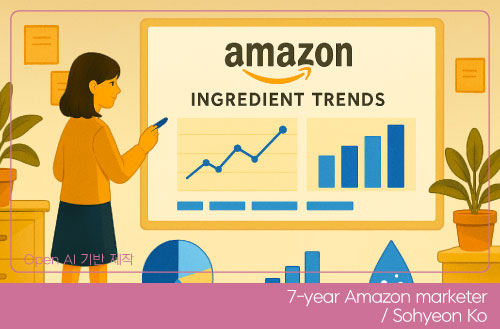
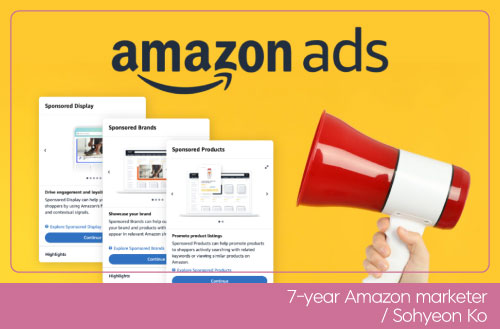

Columnist
So Hyeon Ko AMAZON Team
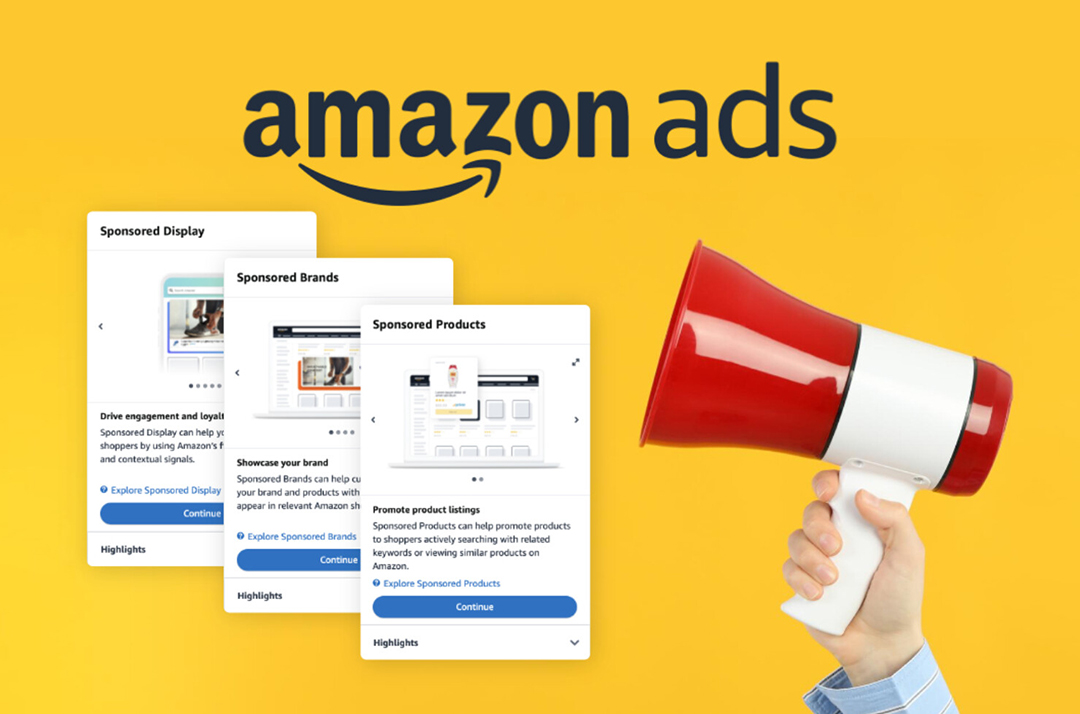
Source: amzigo.com 1)
#INTRO
The Highlight of Amazon Selling
We’ve talked extensively about the importance of basic product detail page elements like product titles and images. But even the most perfectly crafted product page is like an empty model home if no one visits it. That’s why Amazon advertising—which drives traffic to our product pages—is the true highlight of Amazon selling. Just as you’d distribute model home flyers in high-traffic areas with good foot traffic, you need to display your ads on keywords that are likely to generate strong clicks and conversions. In this column, I’ll explain why Amazon advertising is so important and what makes each type of ad different.
1 Why Is Amazon Advertising So Important?
As someone selling on Amazon, advertising on the platform might seem like such an obvious choice that it hardly needs explanation. But let me break it down with some data.
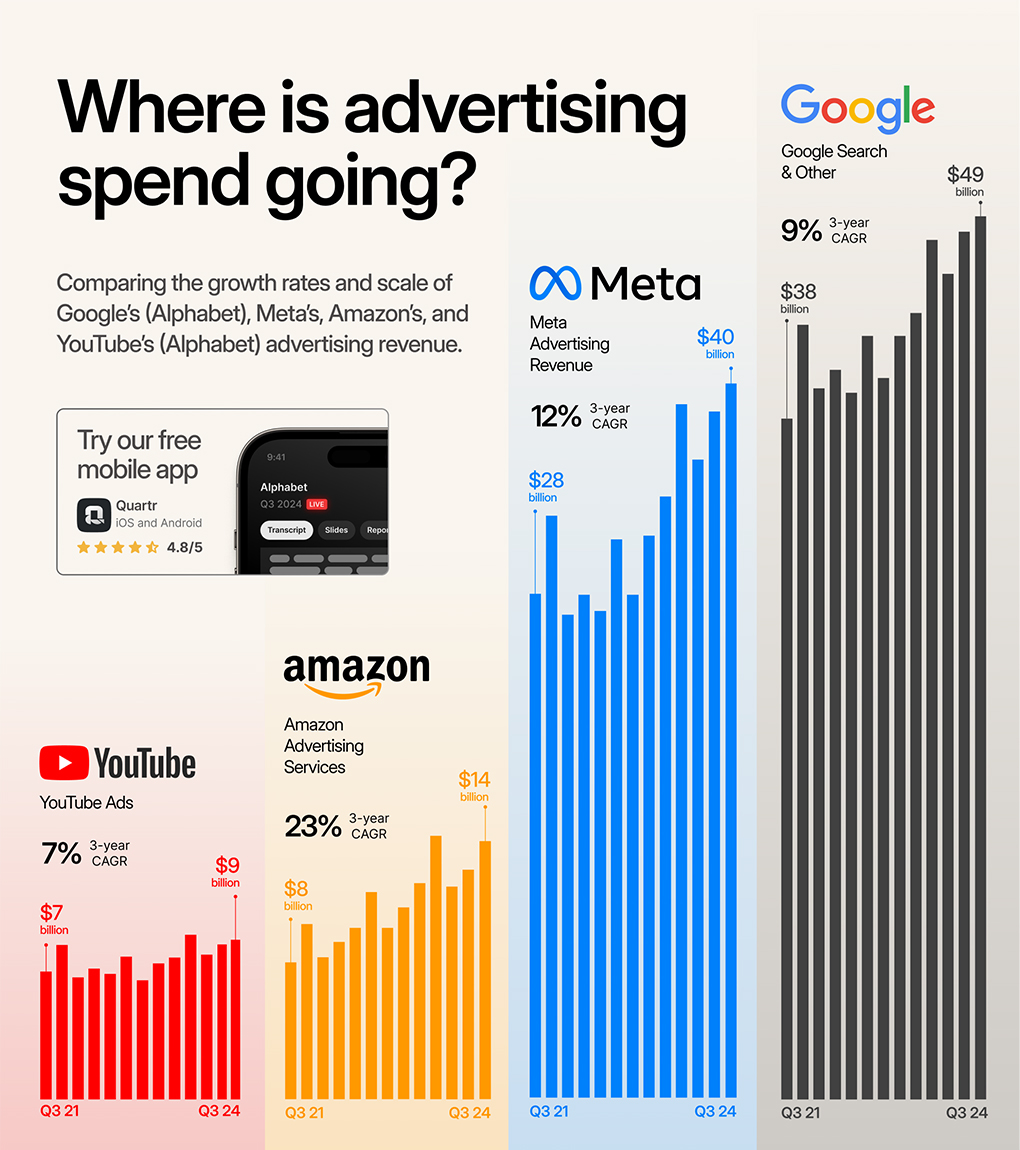
Source: quart.com 2)
Amazon has become a digital advertising powerhouse alongside Alphabet and Meta. As of Q3 2024, it’s been expanding its advertising revenue at an overwhelming pace, with a 23% compound annual growth rate over three years. Amazon advertising has the distinct advantage of being based on customers’ actual purchase data. Plus, beyond the e-commerce platform itself, Amazon can reach a broad consumer base through its own solutions like Prime Video, Alexa, and Fire TV.
What’s more, customers are using Amazon as a channel to discover new brands and products. In fact, 75% of Amazon customers say they use Amazon to discover new products and brands3), and 52% are willing to purchase products from unfamiliar brands. This is precisely why brands and products with low brand awareness need to get exposure to more customers through Amazon advertising.
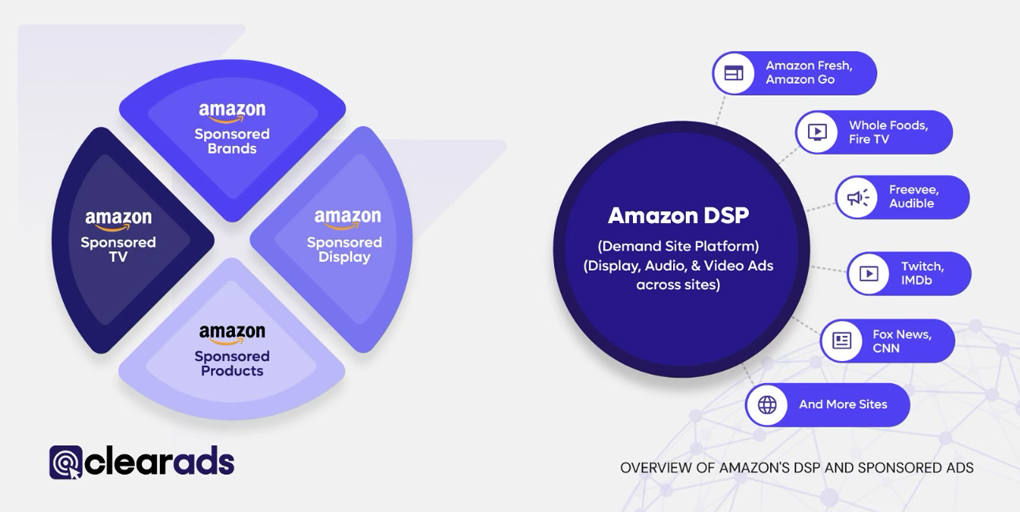
Source: Clearadsagency.com 4)
Given how crucial Amazon advertising is for sellers, Amazon provides various ad formats so you can run efficient campaigns tailored to your objectives and targets. These broadly fall into two categories: Self-service Ads (which include Sponsored Products and Sponsored Brands) and DSP (which can only be managed through agencies). Today, we’ll look at the most commonly used Self-service Ads—specifically, Sponsored Products, Sponsored Brands, and Sponsored Display, which are the most frequently used options.
1) https://www.amzigo.com/articles/the-ultimate-guide-to-amazon-advertising-in-2025
2) https://quartr.com/insights/company-research/the-rise-of-google-meta-amazon-and-youtube-in-advertising
3) https://www.businessdasher.com/amazon-statistics/
4) https://clearadsagency.com/maximising-sponsored-product-performance-with-amazon-marketing-cloud/
2 Sponsored Products: The Most Basic Yet Powerful Weapon
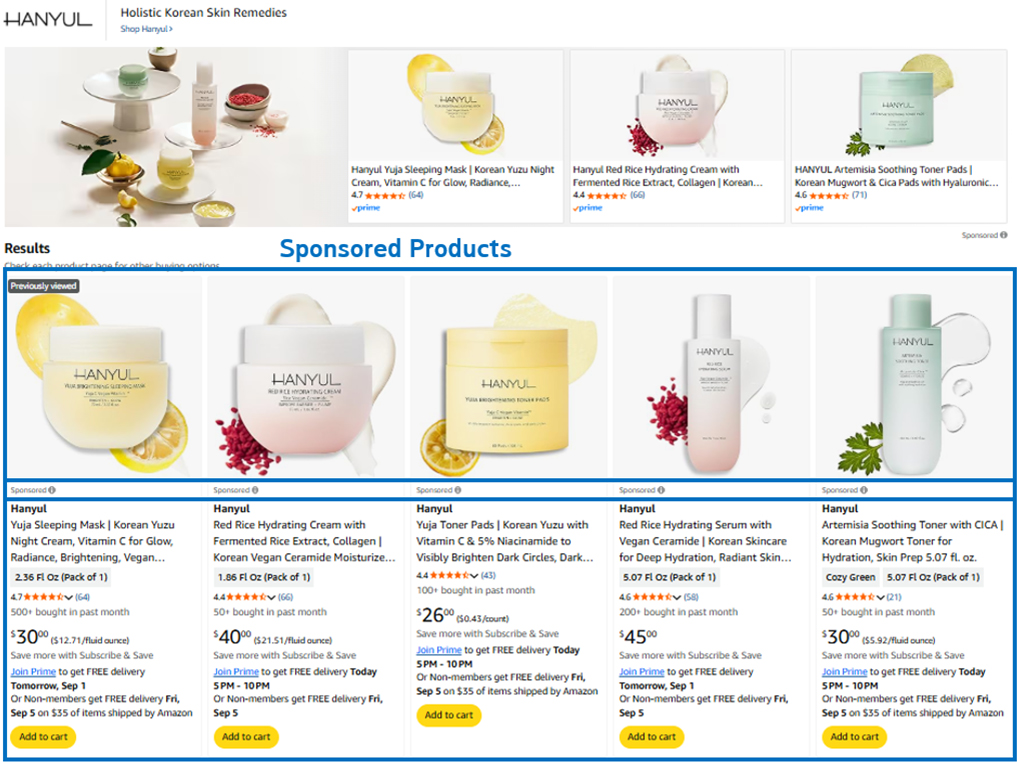
Source: HANYUL Sponsored Products ad screenshot
Since Amazon is a search-based platform, Sponsored Products ads—which primarily appear on search results pages—are the most widely used ad format. They’re displayed at the individual product level alongside the product’s main image, title, ratings, and price, appearing on both search results pages and product detail pages. Because these ads appear at the stage closest to purchase in the customer journey, they use a click-based CPC (Cost Per Click) pricing model.
Targeting options are broadly divided into keyword targeting and product targeting. Keyword targeting offers both Auto and Manual options. Auto mode lets Amazon’s algorithm automatically show your ads for keywords and products that are highly relevant to your product. In contrast, Manual mode enables you to specify target keywords when setting up your campaign. Manual targeting is further divided into three options: Exact, Phrase, and Broad.
- Exact only shows ads for keywords that match your specified keyword exactly
- Phrase shows ads for various keywords that contain your specified keyword (for example, if you enter ‘Moisturizer’, it will also show for ‘face moisturizer for sensitive skin’, ‘Korean moisturizer’, etc.)
- Broad shows ads for a wide range of keywords related to your input keyword (for example, if you enter ‘Moisturizer’, it will also show for ‘Korean skin care’, ‘ceramide cream’, etc.)
You can also run campaigns targeting individual competitor products, specific categories, or competing brands through product targeting. For instance, you could use a strategy to attract customers who are viewing competitor products to your own products.
3 Sponsored Brands: The Power of Increasing Brand Awareness
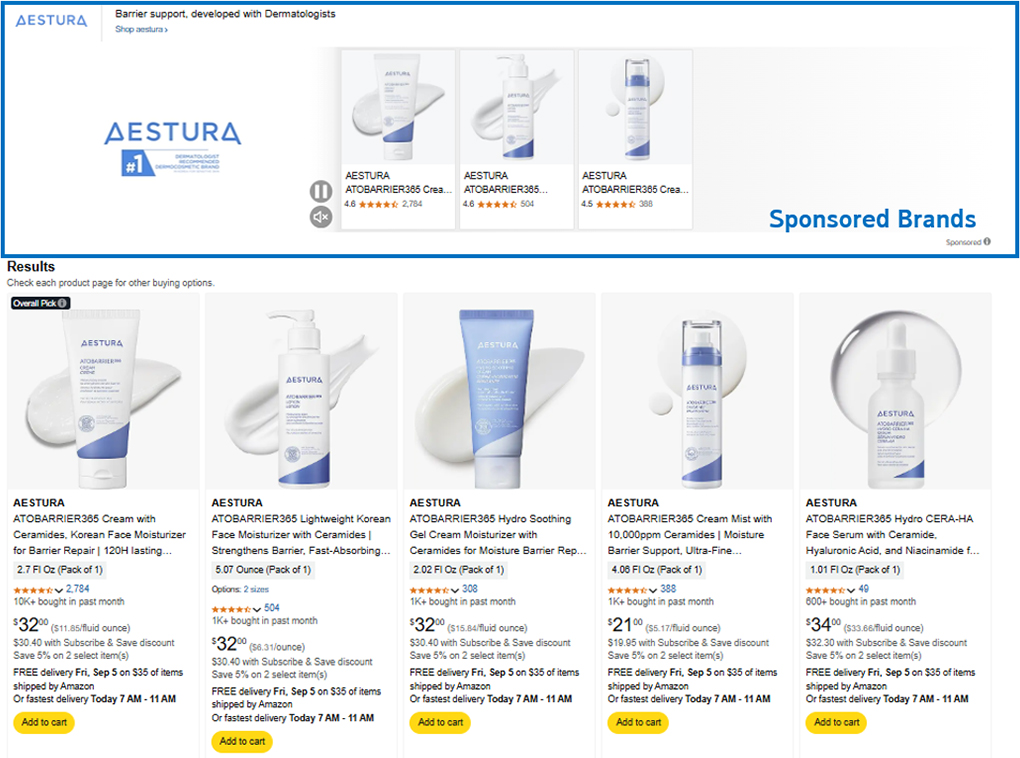
Source: AESTURA Sponsored Brands ad screenshot
While showing products to customers who search specific keywords with purchase intent through Sponsored Products is effective for driving short-term sales, long-term growth on Amazon requires turning customers who’ve experienced your products into loyal brand fans and persuading them through your brand story and values. This is where Sponsored Brands comes in.
Like Sponsored Products, Sponsored Brands appear on search results pages and product detail pages based on keyword or product targeting. Still, it allows you to use brand logos, custom ad copy, images, or videos, and can showcase up to three products. You can also use your Brand Store as a landing page, allowing customers to explore your entire brand beyond just product details.
Unlike Sponsored Products, since Sponsored Brands is also used for brand awareness, you can run campaigns using not only CPC but also vCPM (Viewable Cost Per Mile: cost per 1,000 viewable ad impressions) pricing.
4 Sponsored Display: Exposure Inside and Outside Amazon
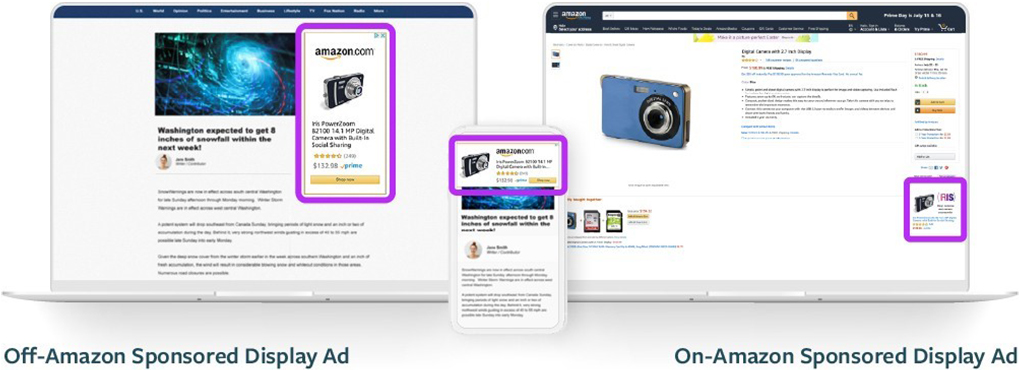
Source: Supplykick.com 5)
Sponsored Display is advertising that appears both inside and outside Amazon. While Sponsored Products and Sponsored Brands allow targeting at the keyword and product level, Sponsored Display lets you target Amazon customer pools organized by specific criteria—and there’s an incredible variety of them. You can target customers who’ve viewed particular categories or products, continuously retarget customers who’ve purchased or clicked on your products (essentially following them to the ends of the earth), and target customers who show high interest in specific categories based on their Amazon browsing and purchase history.
The products someone views and buys reveal a lot about their lifestyle. For example, parents with babies will frequently purchase baby products, and people who buy eco-friendly products are likely very interested in environmental issues. Amazon, with all this data, creates targetable audiences for Sponsored Display based on lifestyles like “parents with children,” “customers who primarily buy discounted products,” and “frequent travelers.” Since this targets specific customer groups rather than keywords, these ads can appear not only within Amazon (on detail pages, search results pages, and the main page) but also outside Amazon (on partner sites, apps, etc.), providing exposure throughout the entire customer purchase journey.
The pricing model supports both click-based CPC and impression-based vCPM. Like Sponsored Brands, you can use both images and videos as creative assets and set custom ad copy. This ad format is optimized for persistently following and persuading customers who are hesitating to purchase your products, or for expanding your new customer base.
5) https://www.supplykick.com/blog/amazon-sponsored-display
5 Useful Amazon Advertising Tips Worth Knowing
This column seems particularly long and dry since it covers the fundamental aspects of Amazon advertising. Nevertheless, thank you for reading this far. As a token of my appreciation, I’d like to share just two more useful Amazon advertising tips.
Does Amazon’s advertising revenue only include purchases made immediately after clicking an ad? People are typically reluctant to click ads, and they rarely purchase immediately after clicking, so if that were the logic, it would be hard to expect good ROAS (Return On Advertising Spend). Fortunately, Amazon also uses what’s called an Attribution Window—an advertising attribution period where sales within a specific timeframe after an ad click are recognized as sales attributed to that ad. For third-party sellers, Sponsored Products uses a 7-day window, while Sponsored Brands and Sponsored Display use 14 days, meaning sales within those periods after an ad click count as advertising revenue.
Since CPC is the primary pricing model, when adding targets in Amazon advertising, you need to enter bid values (advertising bid prices) like in an auction. While adjusting bid values for the targets themselves to improve advertising efficiency is beneficial, for more efficient and purpose-driven campaign management, I also recommend adjusting bid values by ad placement and audience.

Source: Amazon advertising dashboard screenshot
Amazon advertising provides data by placement, as shown above. You can set the percentage by which bid values can automatically increase for each placement. For example, Top of Search—one of the placements—literally means the very top of search results pages, and since most clicks on search results pages happen at the top, it tends to have high CTR (Click-Through Rate). However, because competition is fierce, CPC is also measured high. If you want to focus your ad spend on Top of Search, you could lower your base bid value and adjust the Top of Search bid increase rate so your ads primarily appear in Top of Search placements. This way, by checking data for each placement, you can fine-tune bid values to secure more exposure in high-performing placements.
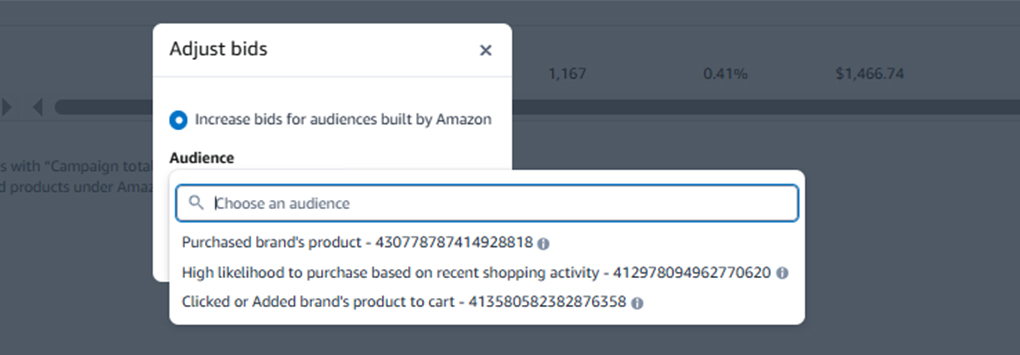
Audiences with Adjustable Bid Values in Sponsored Products
Source: Amazon advertising dashboard screenshot of adjustable audience groups for bid modification
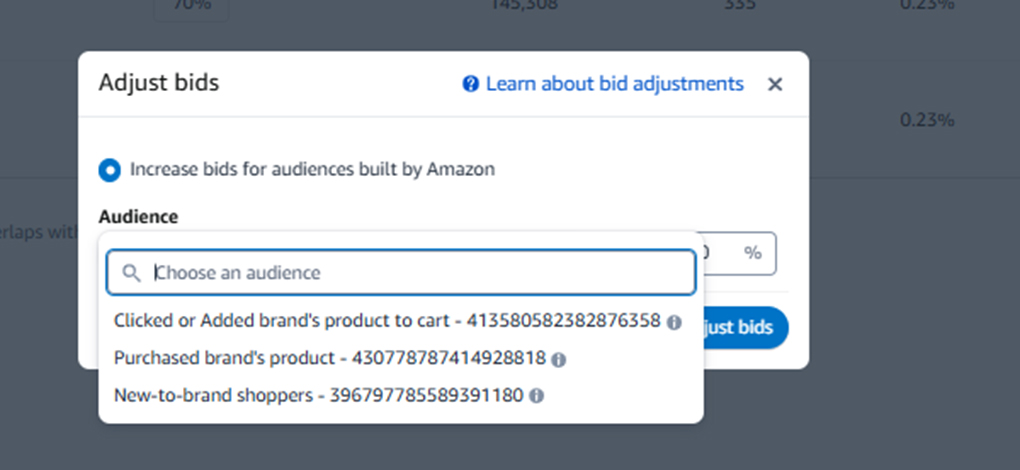
Audiences with Adjustable Bid Values in Sponsored Brands
Source: Amazon advertising dashboard screenshot of adjustable audience groups for bid modification
You can also adjust bid values by the audiences that Amazon has created. For Sponsored Products, you can set up separate bid adjustments for customers who have previously purchased your brand’s products, customers who are likely to buy your products based on recent shopping history, and customers who have clicked on or added your products to their cart. Since Sponsored Brands is a branding-focused ad format, you can adjust bid values for new customers who haven’t purchased your brand yet. Using this feature appropriately based on your advertising objectives can be very useful. For instance, if your goal is to acquire new customers, you can set bid values to increase for new customers. Alternatively, if you’re advertising a discounted product, you can target customers who have previously clicked on that product or only added it to their cart to drive purchases.
#OUTRO
An Endless Domain with No Correct Answers
When someone asks me what makes Amazon interesting, I always point to its constant evolution. The area that best demonstrates this ever-changing nature is advertising. New features are constantly being updated, and keywords that weren’t performing well can suddenly show excellent efficiency. When I discover keywords that make me think “Why would someone who searched for this keyword buy this product?”, it reminds me that the needs I assume are never the whole picture, and that there’s no end to learning—which is incredibly motivating.
High ROAS isn’t always what makes a good ad, and since evaluation metrics change depending on advertising objectives, there’s no correct answer in advertising. Plus, as features continue to be updated, strategies are endless. I hope this column has helped everyone looking at Amazon understand why certain ads are shown to them and what purpose drives a product to target specific keywords.
 |

Sohyeon Ko |
|
|
Amorepacific
|
|
-
Like
1 -
Recommend
1 -
Thumbs up
1 -
Supporting
1 -
Want follow-up article
1



